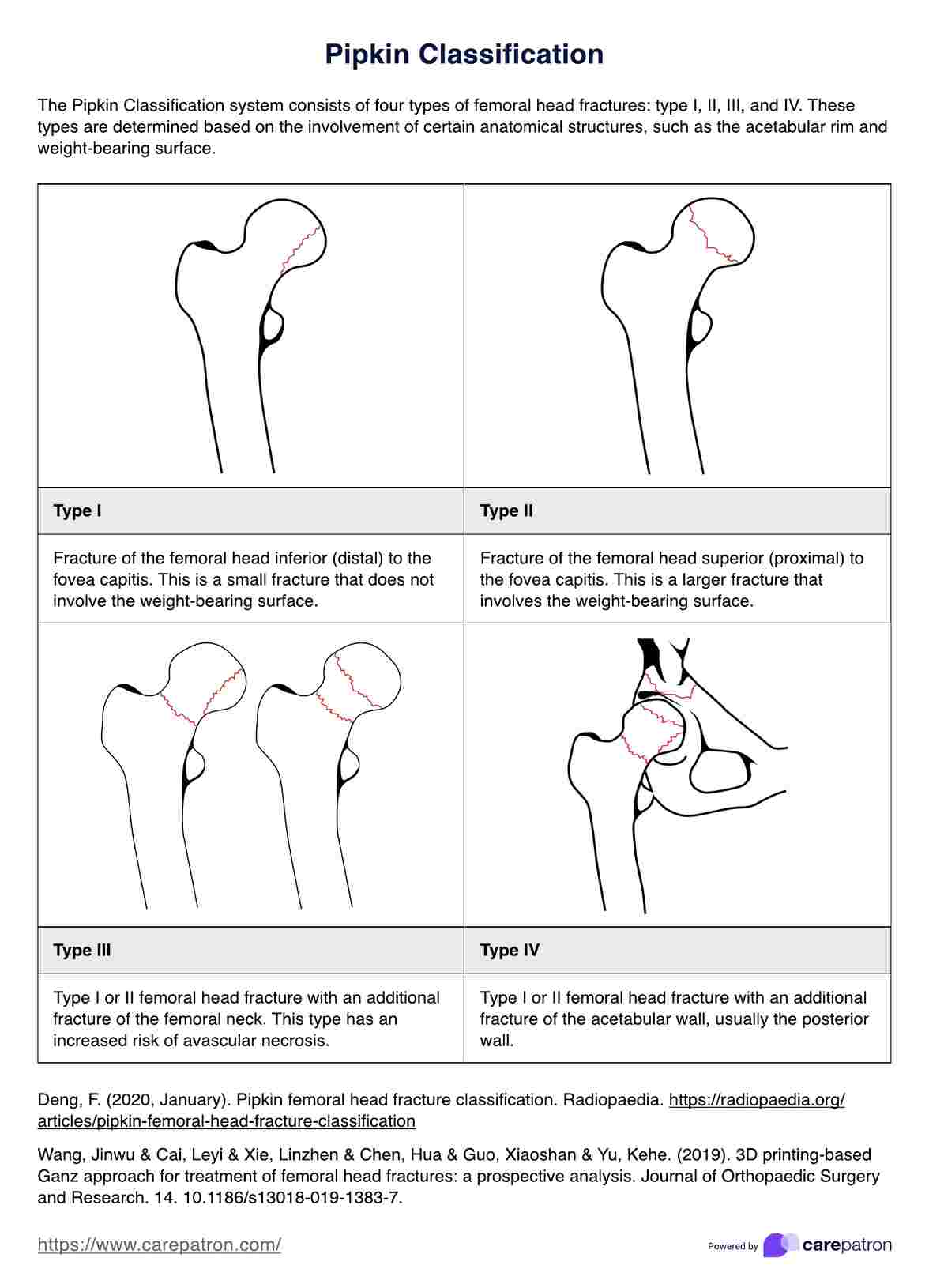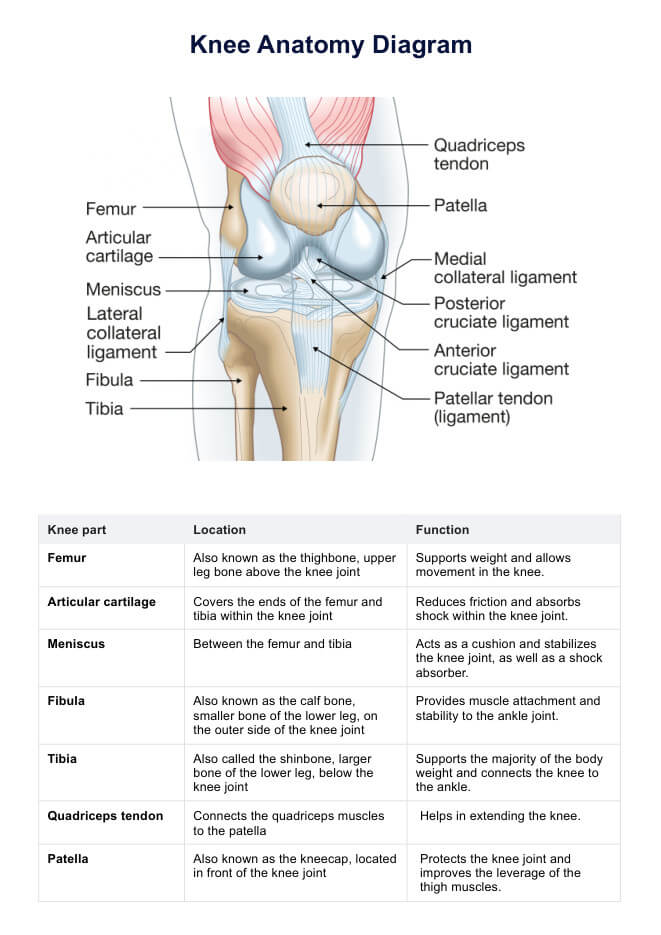Pipkin Classification
Explore the Pipkin Classification system for femoral head fractures, guiding treatment decisions based on fracture location and associated injuries.


What are femoral head fractures?
Femoral head fractures are rare but severe injuries typically resulting from high-energy trauma, such as motor vehicle accidents or falls from significant heights. These fractures often occur in conjunction with posterior dislocation of the hip joint (Menger et al., 2021). Symptoms of a femoral head fracture include severe pain in the hip or groin, inability to move the hip or leg, and visible deformity in the hip area.
Emergency treatment involves urgent closed reduction of the hip joint, followed by either non-operative or operative treatment of the femoral head fracture and any associated injuries, such as femoral neck fractures or acetabular fractures. Long-term complications, such as osteonecrosis of the femoral head, posttraumatic osteoarthritis, and heterotopic ossification, can lead to poor functional outcomes.
Pipkin Classification Template
Pipkin Classification Example
What is the Pipkin Classification system?
The Pipkin Classification system, developed by Garrett Pipkin in 1957, is the most commonly used method to categorize femoral head fractures associated with posterior hip dislocations. This classification provides a framework for understanding the severity and type of fractures, aiding in treatment planning and prognosis.
- Type I: Fracture of the femoral head inferior to the fovea capitis. These fractures occur below the central depression on the head of the femur and often involve a posterior hip dislocation.
- Type II: Fracture of the femoral head superior to the fovea capitis. These fractures occur above the central depression and are associated with more displacement.
- Type III: Type I or II femoral head fracture combined with a femoral neck fracture. This type represents a more complex injury requiring careful management due to the involvement of the neck of the femur.
- Type IV: Type I or II femoral head fracture accompanied by an acetabular fracture. These cases are complicated by the involvement of the socket of the hip joint, making treatment more challenging.
Understanding this classification system helps determine the appropriate intervention, including closed reduction and internal fixation or surgical hip dislocation, depending on the specific type and associated injuries.
How does our Pipkin Classification template work?
Our Pipkin Classification template is designed to guide healthcare practitioners through a structured assessment and classification process for femoral head fractures. This systematic approach helps accurately document the injury severity and determine appropriate management strategies. Here are the steps involved in using the template:
Step 1: Download the handout
Get a copy of our Pipkin Classification template using the link on this page or via the Carepatron app. It's also available from our resources library.
Step 2: Print or use digitally
Print out the handout or use it digitally on your computer, tablet or smartphone. This allows you to easily access the template at any time.
Step 3: Determine classification
Use the information gathered to classify the femoral head fracture according to Pipkin's Classification. This will help guide treatment decisions and ensure appropriate management of the injury.
Step 4: Save and share
Save the template and share it with other healthcare professionals involved in the patient's care. This will provide a comprehensive overview of the injury for better collaboration and decision-making.
How will healthcare professionals benefit from our template?
Healthcare professionals will find our template invaluable for accurately documenting and managing femoral head fractures and associated injuries.
- Structured assessment: Our template provides a systematic framework for evaluating femoral head fractures, including complex cases like Pipkin type II fractures and posterior dislocation of the hip. This structured approach ensures thorough documentation of patient demographics, clinical findings, and imaging results.
- Accurate classification: By using this classification system within the template, healthcare professionals can precisely categorize fractures based on location and associated injuries (e.g., femoral head fracture inferior to the fovea capitis femoris). This classification is crucial for determining appropriate treatment strategies and predicting radiographic outcomes.
- Informed decision-making: The detailed assessment facilitated by our template aids in informed decision-making regarding initial management and subsequent interventions. It helps healthcare providers anticipate potential complications such as posttraumatic arthritis or sciatic nerve injury, guiding proactive patient care.
Reference
Menger, M. M., Braun, B. J., Herath, S. C., Küper, M. A., Rollmann, M. F., & Histing, T. (2021). Fractures of the femoral head: a narrative review. EFORT Open Reviews, 6(11), 1122–1131. https://doi.org/10.1302/2058-5241.6.210034
Commonly asked questions
Healthcare providers use the Pipkin Classification to guide treatment decisions for femoral head fractures. It helps determine whether closed reduction or surgical intervention is necessary based on factors like fracture location, associated injuries, and joint stability.
Type I and II fractures may often be managed with closed reduction alone if there are no complicating factors. Type III fractures typically require surgical intervention due to the complexity and forces involved. Type IV fractures, which involve both the femoral head and acetabulum, necessitate careful assessment and often surgical fixation of both components.
While widely used, the Pipkin Classification's reliability in predicting outcomes and guiding treatment choices can vary. It may not account for all variables like other associated femoral neck fractures, acetabular fracture, comminution or joint stability, and other traumatic dislocations. Its application may require clinical judgment and experience.






































































































